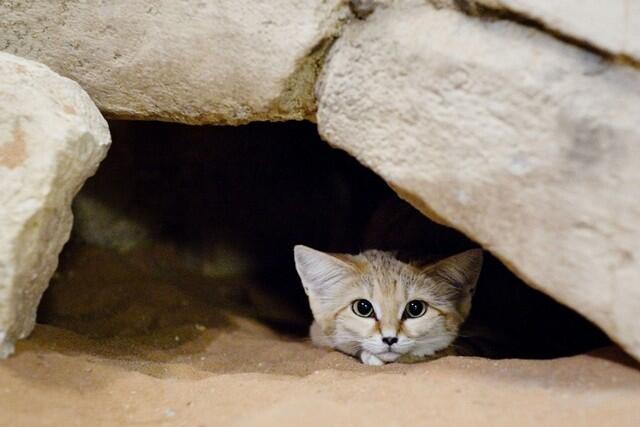For the first time in a decade, the elusive Arabian sand cat has been spotted and photographed in the deserts of the Western Region.
Camera traps in the Baynouna protected areas, set by the Environment Agency Abu Dhabi (Ead), captured stills of three sand cats between March and December last year.
The sightings are a significant step towards estimating the population of the reclusive feline, said Shakeel Ahmed, the agency’s assistant scientist of avifauna, terrestrial and marine biodiversity. They were reported in an article published last month in the European Journal of Wildlife Research.
Researchers said the most recent estimate of the Abu Dhabi sand cat population is more than a decade old and based on a “scarcity of records”. In 2005, fewer than 250 Arabian sand cats were thought to live in the emirate.
The species is considered to be “near threatened” in the deserts of Arabia, North Africa, and parts of Asia, according to the International Union for Conservation of Nature’s Red List of Threatened Species. But in the UAE, the sand cat is listed as endangered.
Ahmed hoped that the photographs of and data from sand cats in the Western Region will help in the recovery of the population.
“We have collected the basic information and now we have expanded the area to explore more cats in that area,” he said.
Researchers from Ead and Al Ain Zoo initially set up five cameras around a 1,990-square-metre area in the Western Region, about 150 kilometres west of Abu Dhabi.
With sandy plains and small dunes covered with dwarf shrubs and other native vegetation, it is the perfect habitat for Arabian sand cats, which thrive in desert environments where they can feed on rodents, small reptiles and large insects.
To help lure the shy felines towards the motion-censored cameras, researchers planted open cans of chicken- and fish-flavoured cat food.
“Mostly, I used the chicken one because it was very successful in studies that were done in Saudi Arabia,” said Ahmed. “It’s very effective in attracting the animals.”
Less than one month after setting their camera traps and treats, the researchers recorded their first image of a sand cat.
The picture was shared with regional experts to help identify the species, known for its large, pointy ears, broad head and dark horizontal bands around its front legs.
Four more cameras were added and by December last year, five had captured 46 sightings of one male and two female sand cats. Other wildlife photographed, such as rodents, geckos and large beetles, indicated that the cats had plenty to feed on, researchers said.
Hessa Al Qahtani, head of conservation at Al Ain Zoo, said the findings are significant.
“We don’t have accurate data on how many of them are in the wild, and because of that, the study that Ead has conducted at Baynouna in Abu Dhabi, and the finding of three cats, is indeed important because it is going to tell us about the population size,” she said.
Al Ain Zoo is home to the world’s largest captive population in the world, with 33 Arabian sand cats.
It maintains specialised holding and breeding facilities for the felines and hosts workshops for regional sand cat experts to develop conservation strategies.
The goal is both to ensure the health of the captive population and to study wild sand cats to understand the threats facing them and how to protect them, Ms Al Qahtani said.
“They are a very sensitive species, and it’s not easy to study them,” she said. “They are very tricky. They are very elusive.”
Source: The National
Author: Roberta Pennington











